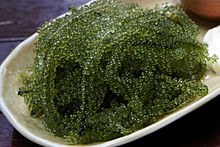Caulerpa lentillifera
| Caulerpa lentillifera | |
|---|---|
 |
|
| Scientific classification | |
| Kingdom: | Plantae |
| Division: | Chlorophyta |
| Class: | Bryopsidophyceae |
| Order: | Bryopsidales |
| Family: | Caulerpaceae |
| Genus: | Caulerpa |
| Species: | C. lentillifera |
| Binomial name | |
|
Caulerpa lentillifera J. Agardh |
|
Caulerpa lentillifera is a species of bryopsidale green algae from coastal regions in the Indo-Pacific. This seaweed is one of the favored species of edible Caulerpa due to its soft and succulent texture. C. lentillifera is farmed and eaten in the Philippines, where it is locally known under various names including latô, gusô, and arosep; in the Malaysian state of Sabah, where it is known as latok; and in Okinawa, Japan, where it is known as umi-budō (海ぶどう?), meaning "sea grapes." It is sometimes known in English as green caviar or sea grapes.
C. lentillifera is usually eaten raw with vinegar, as a snack or in a salad. In the Philippines, after being washed in clean water, it is usually eaten raw as a salad, mixed with chopped raw shallots and fresh tomatoes, and dressed with a blend of fish sauce or bagoong (fish paste) and vinegar. It is known to be rich in iodine.
The pond cultivation of C. lentillifera has been very successful on Mactan Island, Cebu, in the central Philippines, with markets in Cebu and Manila. About 400 ha of ponds are under cultivation, producing 12–15 tonnes of fresh seaweed per hectare per year.
...
Wikipedia
